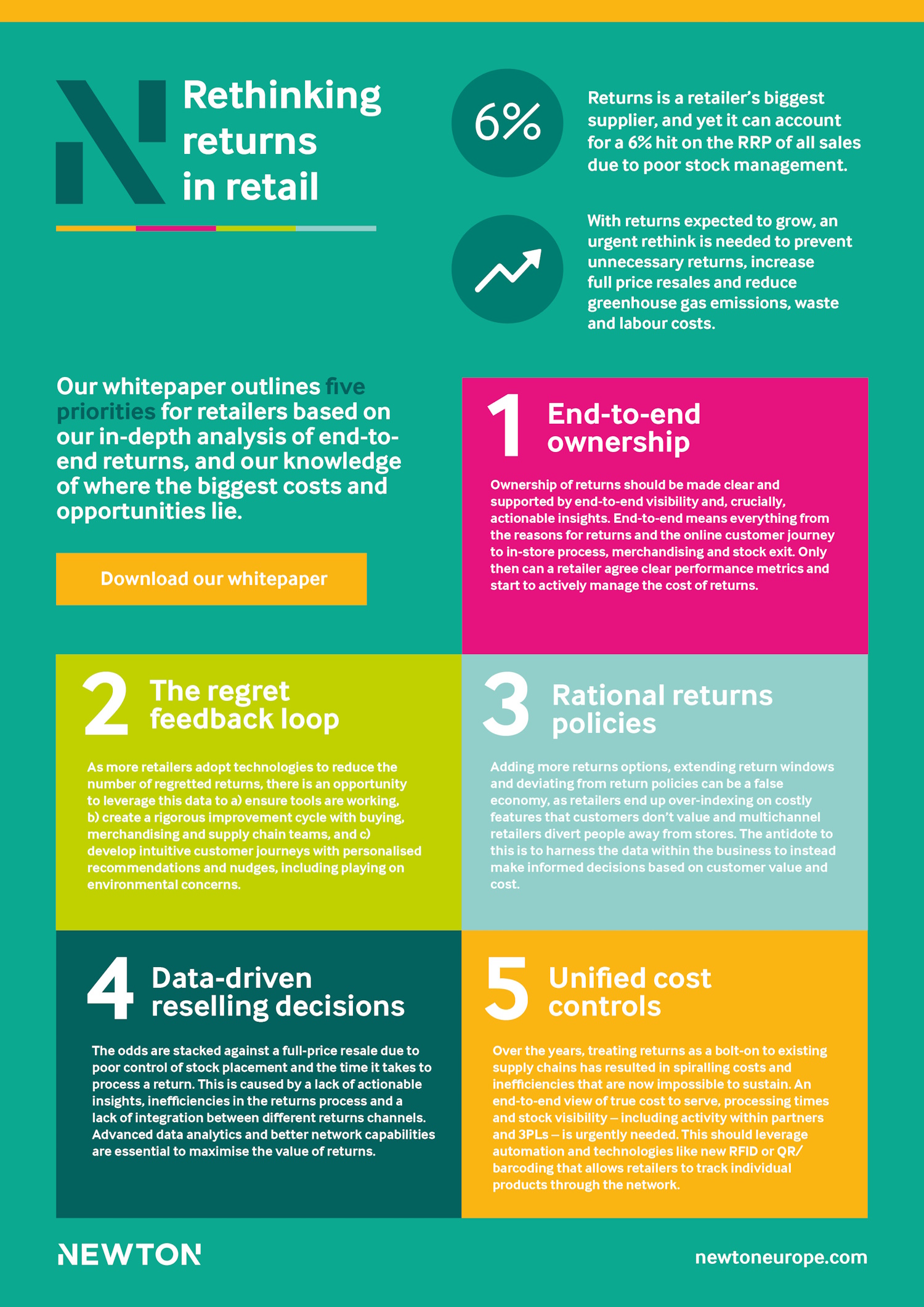Most retailers don’t realise that returns are their biggest supplier, or understand their true cost.
When we’ve taken a deep dive into a retailer’s returns data and showed them where their biggest opportunities are, there are two things that inevitably surprise them:
- If you look at returns as a whole, they are a retailer’s biggest supplier
- Returns can account for a 6% hit on the RRP of all sales
It’s an alarming statistic and not something that retailers can sustain, especially in the current economic climate. These issues are set to worsen as online shopping – and therefore the volume of returns – continues to grow.
It really brings home the true scale of the issue and the urgency with which retailers need to start rethinking how they manage returns while delighting their customers. The truth is, there’s a large number of missed opportunities to reduce the cost of returns, and a lot of value that isn’t being realised.
The issues with returns are largely due to a lack of ownership and end-to-end visibility, leading to a lack of insight into how returns move through the business and where the biggest costs and opportunities lie. The cost is so much more than what you pay your third party logistics providers.
As a result of this lack of oversight, inefficient processes become more deeply embedded, and new initiatives – whether that’s a new sizing tool, an updated returns policy or a new returns channel – fail to deliver the intended benefits and can even make things worse.
Based on our forensic analysis of end-to-end returns, I’ve summarised five new insights and how retailers should rethink returns to minimise the cost and maximise the value of this stock.
Insight 1: Returns are a retailer’s biggest supplier
They say prevention is better than cure, and while some returns are inevitable, there are currently too many regretted returns. While some retailers have used tactics like sizing tools and fraud-proof packaging to tackle the issue, our research shows that these don’t always have the desired effect.
Crucially, retailers need to make sure they have the right information to understand customer behaviours, decide what tactics are needed, and assess if they’re working. They should also feed insights back to buying, merchandising and supply chain teams as part of a rigorous improvement cycle.
Better insights will ensure retailers are getting the most out of their prevention tactics and coming up with targeted innovations that work.
Insight 2: Returns account for a 6% hit on the RRP of all sales
A lack of ownership and visibility means the cost of returns is hidden in the P&L. This has allowed returns to reach a point where it now urgently needs solving.
As with any major supplier, returns require clear ownership that’s supported by end-to-end visibility and meaningful insights. End-to-end means everything from the reasons for returns and the online customer journey to in-store processes, merchandising and stock exit. Only then can a retailer agree on clear performance metrics and start to actively manage costs.
Insight 3: Returns can take up to a month to process
When you add on a 30-day returns window, this means that seasonal stock especially is unlikely to be resold at full price, if at all. We’ve seen instances of summer clothing not being available to be resold until more than 100 days after the initial sale, because the returns policy was overridden and the process was so inefficient. Other factors include poor computer systems and the inability to move stock between different channels to meet consumer demand.
Retailers need the right policies, processes and network capability in place to get stock to the right place at the right speed and for the right cost. For one retailer, we helped to set up a new, cheaper route between stores in a local area to improve stock availability.
Insight 4: Retailers are under-using their physical estate
Despite the explosion of alternatives on offer, customers still prefer to return items in-store, and this remains one of the most cost-effective and value-adding options for retailers. And yet we see retailers over-indexing on returns options that customers don’t value and that cost them dearly in service fees. This is because they don’t understand what customers truly value, even though there are ways of seeing this in their own data, without having to gather this directly from consumers.
Data analytics can help retailers to make more informed decisions about returns policies and nudge customers towards more efficient routes.
Insight 5: Returns are a reputational issue waiting to happen
Returns are a blight on every retailer's sustainability strategy, whether it's the extra road miles, the products that can’t be resold or the extra cleaning and packaging required.
The big danger for retailers is a lack of visibility of returns, which means they can’t answer the question: how many returns do you have, what is the environmental impact and what are you doing to address this? Questions like this become harder to ignore as retailers shout louder about their green credentials and businesses attract more scrutiny from consumers, investors and regulators.
End-to-end ownership and visibility of returns is critical to gaining an accurate understanding of their environmental impact and coming up with a plan to address this, including actions required of internal teams and third parties.
Read our whitepaper on rethinking returns, and get in touch to discuss your challenges and how we can help with your future plans: www.newtoneurope.com/returns-plc
To find out more about Newton Europe and the services they provide to the retail industry, click here.
This article was also published in The Retailer, our quarterly online magazine providing thought-leading insights from BRC experts and Associate Members.

